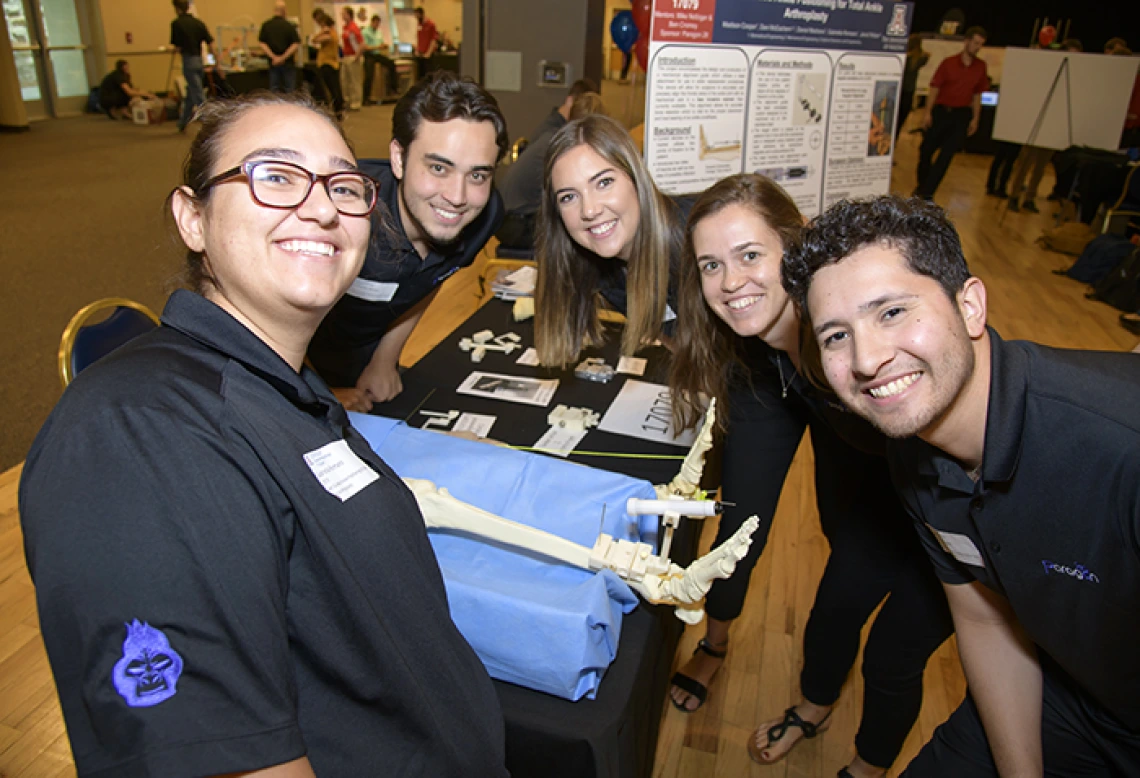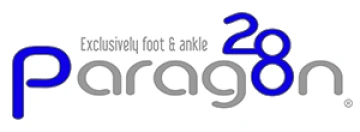Winning Design Day Team Helps People Stand on Their Own Two Feet


Project Title: Laser-Guided Ankle Positioning for Total Ankle Arthroplasty
Team 17079 Members:
Madison Cooper, biomedical engineering
Dani McEachern, biomedical engineering
Daniel Medrano, mechanical engineering
Gabriella Romano, biomedical engineering
Jarod C. Weber, electrical and computer engineering
Sponsor: Paragon 28
Laser-Focused Seniors Design Ankle Alignment Accuracy
In total ankle arthroplasty, or ankle replacement, procedures, surgeons must ensure that placement of an ankle prosthesis is aligned correctly with the patient’s hip, while still allowing the ankle to have six degrees of freedom of movement.
Surgeons ensure this alignment by cutting two fixation points on the patient’s ankle and shin. This introduces two sites of trauma and two sites for possible infection, and increases recovery time and the number of steps in postoperative protocol.
For their senior project, Team 17079 designed a system that uses a laser beam shining from ankle to hip to attain the correct alignment, eliminating the need for a second fixation point and achieving a level of accuracy that exceeds existing methods.
“This could open doorways to rethink the way we do orthopedic surgery,” said team leader Daniel Medrano.
To do it, they exceeded the project requirements, going through three prototypes of the finished product, and many more rounds of prototyping for each of the system’s custom-designed components.
Team member Gabriella Romano used the research lab she works in to 3D-print the first prototype for the laser mount and brought it home in her backpack. That night, her house was robbed, and her backpack — laptop, prototype and all — were gone.
Beating the ‘Bad News Bears’ Luck
“I think I had the prototype for all of two hours,” she said. “If they made an underdog or a ‘Bad News Bears’ story for engineers, that was us.”
But the team didn’t give up hope. They forged ahead with their prototyping and called in associate professor of orthopedic surgery and biomedical engineering Dr. Daniel Latt, an orthopedic surgeon, to perform two mock procedures using their device.
His feedback indicated the guide was easy to use and improved one of the most important alignment steps in the surgery. Their average angular deviation was +/- 0.75 percent, lower than current alignment guides on the market.
Frank Barmes, a project engineer at Paragon 28 and one of the team’s corporate mentors, said he appreciated what the students’ diverse experiences and interests brought to the project. The company has even submitted a provisional patent application for the device.
“The team worked well together for great results,” he said. “We fully expect to continue the project through commercialization.”
Hard Work, Sacrifice Earn Design Day Win
The team spent hours practicing their presentation in the days leading up to Design Day. They were proud of their hard work, but weren’t expecting any outstanding accolades when the big event rolled around.
Once it arrived, they were surprised by the number of people — both judges and passers-by — who told them their device could make a real impact in the medical field. When they were announced as the winners of the Raytheon Award for Best Overall Design, the $5,000 top prize, their jaws dropped.
One of the first people to come up to Romano was her academic adviser, who assured her that the whole team would have no problem finding jobs after their win.
“My group and I worked endlessly on this project, and at times we had to sacrifice other classes’ study time,” Medrano said. “But, in the end, it was well worth our efforts because it has changed our future. And how many engineering students can say they won Design Day?”

